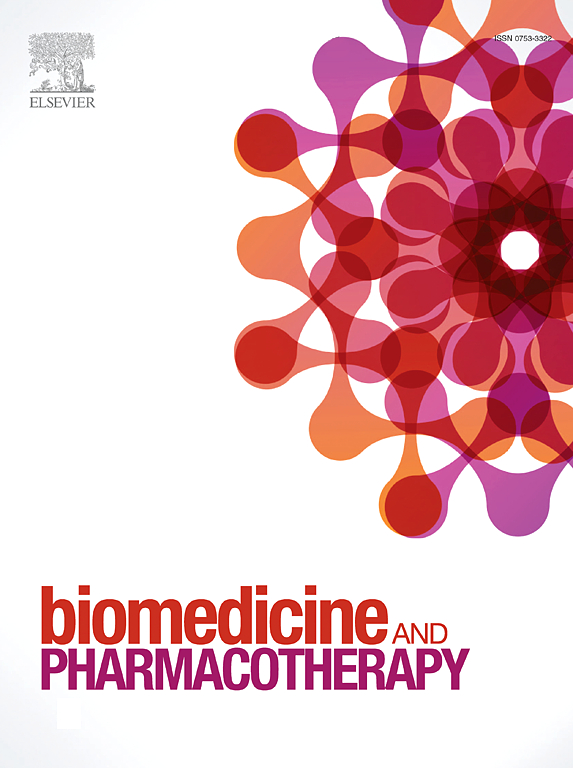黄柏碱通过PKM2调节小胶质细胞的Warburg效应,改善脂多糖诱导的焦虑样行为。
IF 6.9
2区 医学
Q1 MEDICINE, RESEARCH & EXPERIMENTAL
引用次数: 0
摘要
小胶质细胞介导的神经炎症被认为是焦虑的主要原因和病理过程。在小胶质细胞活化过程中,观察到小胶质细胞糖酵解异常。然而,调节小胶质细胞中的Warburg效应是否能有效干预焦虑及其潜在机制尚不清楚。本研究的重点是coptisine (Cop),一种调节糖酵解和影响焦虑的小胶质细胞功能的天然生物碱。在脂多糖(LPS)诱导的小鼠焦虑模型中,评估Cop对焦虑样行为、海马突触功能和小胶质细胞过度激活的影响。我们利用表达突变型pyruvate kinase isoform M2 (PKM2)的小胶质细胞进一步研究Cop调控小胶质细胞表型的分子机制。进一步的研究表明,Cop附着在PKM2的氨基酸残基苯丙氨酸26上,使PKM2的动态平衡向四聚体转移,并增强其丙酮酸激酶活性。这种相互作用阻止了lps诱导的Warburg效应,并灭活了小胶质细胞中PKM2/缺氧诱导因子-1α (HIF-1α)通路。总之,Cop通过调节小胶质细胞中的Warburg效应来减轻焦虑。我们的工作首次揭示了PKM2/(HIF-1α)通路在焦虑中的作用。重要的是,Cop改善焦虑样行为的分子机制是通过调节PKM2的二聚体/四聚体形式,表明PKM2作为治疗焦虑的关键潜在靶点的有效性。本文章由计算机程序翻译,如有差异,请以英文原文为准。
Coptisine improves LPS-induced anxiety-like behaviors by regulating the Warburg effect in microglia via PKM2
Neuroinflammation mediated by microglia is considered the primary cause and pathological process of anxiety. Abnormal glycolysis of microglia is observed during microglia activation. However, whether regulating the Warburg effect in microglia can effectively intervene anxiety and its potential mechanisms have not been elucidated. This study focused on coptisine (Cop), a natural alkaloid that regulates the glycolysis and function of microglia affecting anxiety. The effects of Cop on anxiety-like behaviors, hippocampal synaptic function, and excessive activation of microglia were assessed in lipopolysaccharide (LPS) induced mouse models of anxiety. Microglia expressing mutant pyruvate kinase isoform M2 (PKM2) were used to further investigate the molecular mechanism by which Cop regulates the phenotype of microglia. neuroinflammatory is emerging Further research revealed that Cop attaches to the amino acid residue phenylalanine 26 of PKM2, shifting the dynamic equilibrium of PKM2 towards tetramers, and enhancing its pyruvate kinase activity. This interaction prevented LPS-induced Warburg effect and inactivated PKM2/hypoxia-inducible factor-1α (HIF-1α) pathway in microglia. In conclusion, Cop attenuates anxiety by regulating the Warburg effect in microglia. Our work revealed the role of PKM2/(HIF-1α) pathway in anxiety for the first time. Importantly, the molecular mechanism by which Cop ameliorates anxiety-like behaviors is through modulation of the dimeric/tetrameric form of PKM2, indicating the usefulness of PKM2 as a key potential target for the treatment of anxiety.
求助全文
通过发布文献求助,成功后即可免费获取论文全文。
去求助
来源期刊
CiteScore
11.90
自引率
2.70%
发文量
1621
审稿时长
48 days
期刊介绍:
Biomedicine & Pharmacotherapy stands as a multidisciplinary journal, presenting a spectrum of original research reports, reviews, and communications in the realms of clinical and basic medicine, as well as pharmacology. The journal spans various fields, including Cancer, Nutriceutics, Neurodegenerative, Cardiac, and Infectious Diseases.

 求助内容:
求助内容: 应助结果提醒方式:
应助结果提醒方式:


